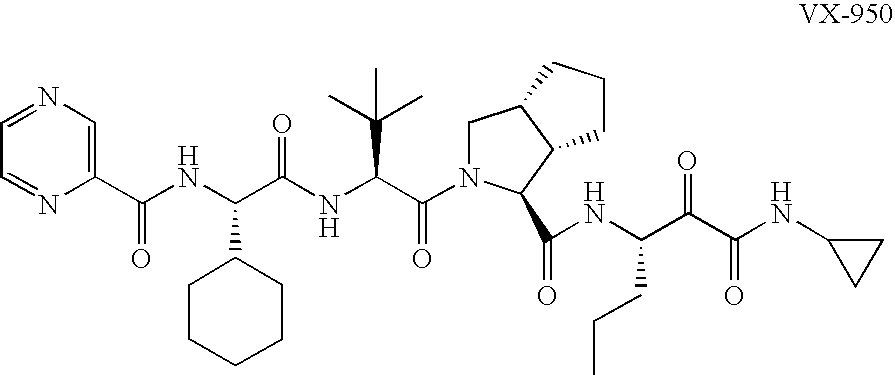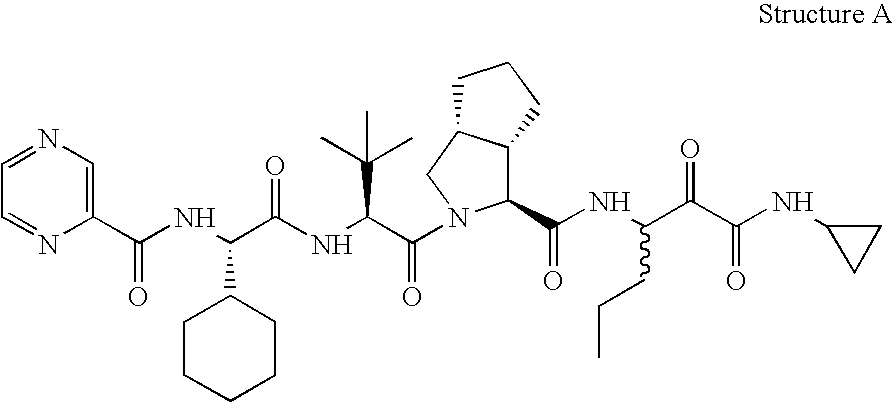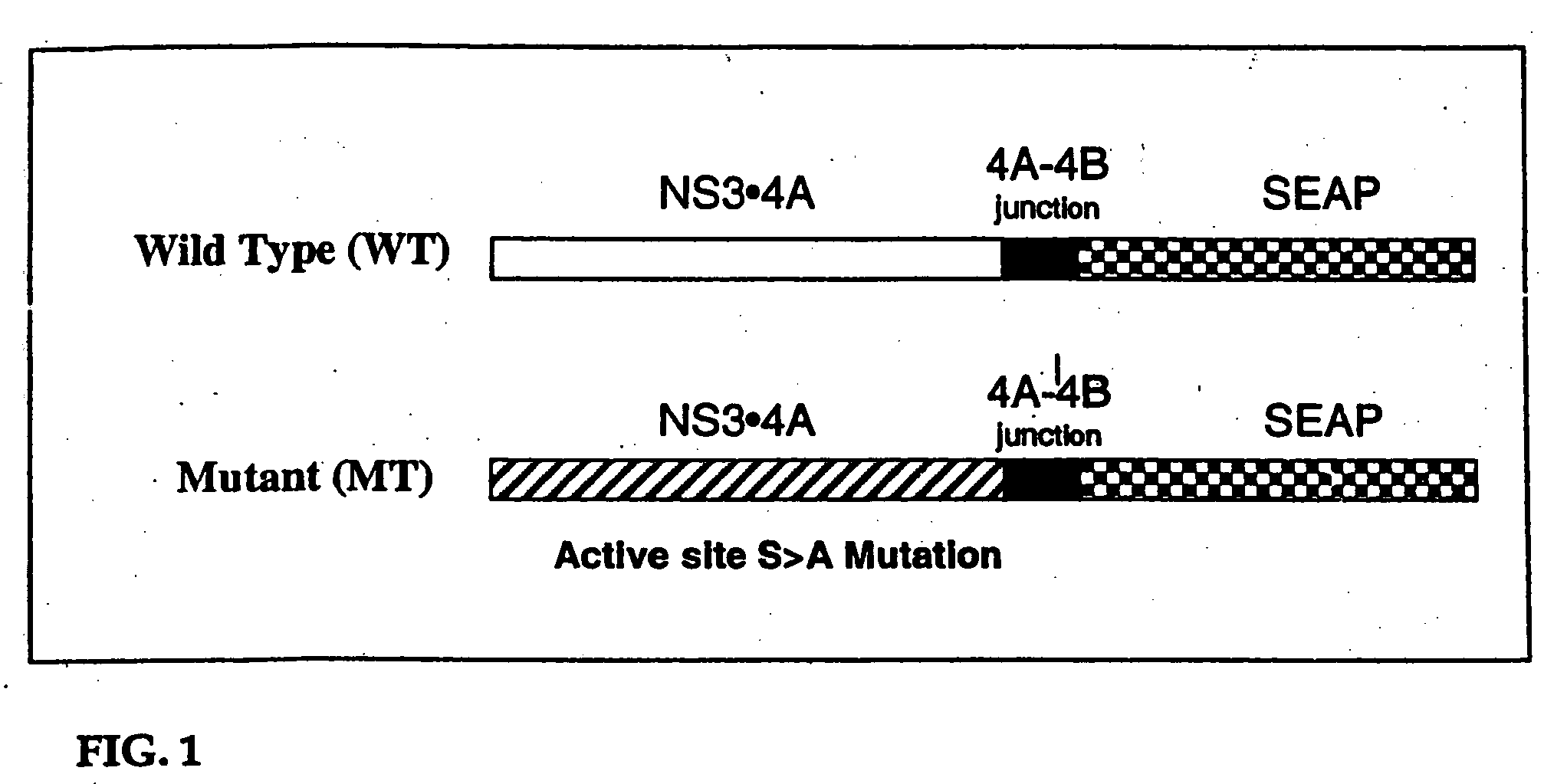Animal model for HCV infection
a model and animal technology, applied in the field of non-transgenic, non-human animals, can solve the problems of insufficient anti-hcv agents or treatments, uncertain prospects for effective anti-hcv vaccines, and significant side effects of interferons, and achieve the effect of reducing seap secretion
- Summary
- Abstract
- Description
- Claims
- Application Information
AI Technical Summary
Benefits of technology
Problems solved by technology
Method used
Image
Examples
example 1
Design and Construction of Reporter Genes
[0181] Over lapping PCR was used to fuse cDNA encoding HCV NS3•4A and secreted placental alkaline phosphatase. HCV NS3•4A DNA was PCR amplified using: [0182] a) NS4A U2 5′CAG CAG CAG GTA AGG GAG GTG TGA GGC GCA CTC TTC CAT CTC ATC GAA CTC 3′ as the upper primer with: [0183] b) NS4A L4 5′ TGT CTG TCA TCC CGA CCA ACG3′ as the lower primer. This resulted in a PCR product of 893 bp using pYes2 / NS3•4A plasmid as a template. PCR conditions were 94° C. for 45 secs., 50° C. for 45 secs., 72° C. for 1 min.
[0184] Similarly, the secreted placental alkaline phosphatase (SEAP) was PCR amplified: [0185] a) SEAP L3 5′AGTG AGA TCT GCGGCCGC TTA TCA TGT CTG CTC GAA GC GG3′ as the lower primer with [0186] b) SEAP U 5′ TCA CAC CTC CCT TAC CTG CTG CTG CTG CTG CTG C3′ as the upper primer with PCR conditions 94° C. 45 secs., 55° C. 45 sec and 72° C. for 1.3 minutes.
[0187] The resultant PCR products were gel purified using a Qiaex II gel extraction kit (Cat#20021...
example 2
Cloning of PCR Product in Plasmid Vectors
[0197] The 2.5 kb over lap PCR product was restriction digested with SalI and BglII and cloned into pYes NS3•4A encoding either the wild type HCV protease (WT) or the mutant (MT) protease containing a serine to alanine mutation in the active site of HCV protease using T4 DNA ligase (New England Biolabs). The 3.7 kb HindIII-NotI cDNA fragment encoding HCV NS3•4A SEAP was cloned into the pCEP4 mammalian expression vector. The resultant clones were subjected to DNA sequencing at the DNA core facility of Vertex Pharmaceuticals Incorporated.
example 3
Expression of the HCV-SEAP Reporter Plasmids in Cell Culture
[0198] CRL 1830 mouse hepatocytes in 12 well plates were transfected with 2.4 μg of pCEP4 encoding either HCV WT NS3•4A SEAP or SEAP cDNA with lipofectamine2000 (Invitrogen). CRL 1830 mouse hepatocytes in 12 well plates were transfected in duplicates with 2.4 ugm of HCV WT NS3•4A SEAP and HCV MT NS3•4A SEAP. 72 hours post transfection the medium was assayed for SEAP activity. As shown in FIG. 6, cells transfected with the WT HCV Protease construct secreted more SEAP into the media than cells which received the mutant (MT) protease.
[0199] In the experiment shown in FIG. 7, CRL 1830 mouse hepatocytes in 12 well plates were transfected with pCEP4 encoding either HCV WT NS3•4A SEAP or SEAP cDNA with lipofectamine2000 (Invitrogen) and treated with various concentrations of HCV protease inhibitor ranging from 0 to 40 μM. 48 hours later the medium was assayed for SEAP activity. FIG. 7 shows the dose dependent inhibition of SEAP ...
PUM
 Login to View More
Login to View More Abstract
Description
Claims
Application Information
 Login to View More
Login to View More - R&D
- Intellectual Property
- Life Sciences
- Materials
- Tech Scout
- Unparalleled Data Quality
- Higher Quality Content
- 60% Fewer Hallucinations
Browse by: Latest US Patents, China's latest patents, Technical Efficacy Thesaurus, Application Domain, Technology Topic, Popular Technical Reports.
© 2025 PatSnap. All rights reserved.Legal|Privacy policy|Modern Slavery Act Transparency Statement|Sitemap|About US| Contact US: help@patsnap.com



